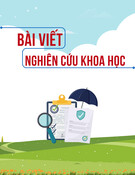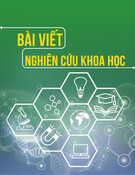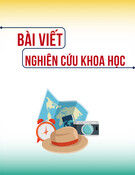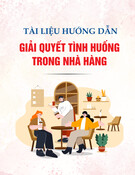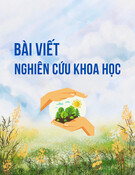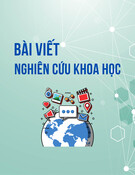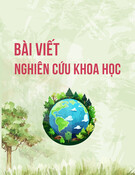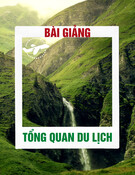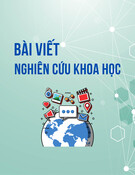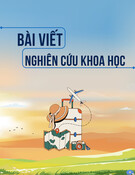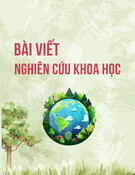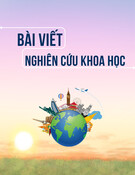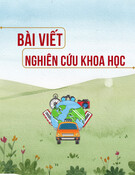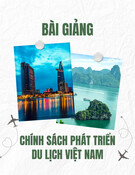
p-ISSN 1859-4417 e-ISSN 3030-4822
36
Summary
This study aims to conduct an in-depth analysis of Taiwan's sports, culture and tourism
resources, explore the problems existing in the integrated development of sports culture and tourism
industry, and put forward scientific and feasible development strategies. In this study, RMP
theoretical analysis, literature analysis and logical analysis are used to conduct a comprehensive
analysis of Taiwan's tourism resources, markets and products, and deeply explore the path of
integrated development of Taiwan's sports, culture and tourism industries. According to the results
of this study, three strategies are proposed: make good use of resources to carry out characteristic
sports culture tourism, hold diversified sports culture activities, and promote the integrated
development of sports culture tourism industry chain. These three strategies not only contribute to
the sustainable development of Taiwan's sports and cultural tourism, but also provide a theoretical
basis for policy formulation and further enhance industrial competitiveness and international visibility.
Keywords: Cultural Tourism, Sports Tourism, Industry Integration, Strategy Research.
(1)Assoc. Prof,(2)Master,(1)Assoc. Prof PhD, School of Physical Education, Minnan Normal University
Hsing-Chieh Huang(1);Yi-Yang Chen(1); Su-Ting Wu(2); Chien-An Chen(3)
INTRODUCTION
Covid-19 has had a huge impact on the global
tourism industry, and Taiwan has seen a steady
decline in visitors from 2020 to 2021. The
loosening of the epidemic prevention policy in
2022 will usher in retaliatory growth of public
tourism. With the doubling of Taiwan people's
demand for health awareness and leisure
activities, people are more willing to engage in
sports tourism activities, thus promoting the
development of Taiwan's sports tourism industry
(Huang & Wu, 2022). Sports tourism includes
activity content, venue, organization, cultural
heritage, folk customs and natural resources, etc.
The integration of sports and tourism industry
with local residents' culture is a form of sports
and tourism that has arisen in recent years to meet
people's demand for experiential and ornamental
sports. It is also an important indicator to improve
the quality of healthy life and the development of
civilization (Ma, C., Wang, X., & Li, S., 2023).
Culture is also the soul of people participating
in tourism activities. Only through the integrated
development of sports, culture and tourism can
we meet the needs of modern tourism
consumption and promote industrial
transformation and upgrading (Huang, H. C. &
Wu, S. T. (2022)). Culture is an important
attraction of sports tourism, tangible and
intangible cultural assets such as the image of the
destination, cultural heritage, art and social
values, Will affect the participation interest of
tourists (Lohana, S., Imran, M., Harouache, A.,
Sadia, A., & Rehman, Z. U., 2023). The
characteristics of sports culture in different places
have also become an important feature of sports
tourism. This deep-rooted traditional sports
culture provides an important channel for sports
and culture to realize commercialization through
tourism, and also creates a lot of benefits for the
integrated development of local industry,
economy and culture (Hinch, T. D., 2006). This
paper aims to conduct an in-depth analysis of
Taiwan's sports, culture and tourism resources,
explore the problems existing in the integrated
development of sports culture and tourism
industry, and put forward scientific and feasible
development strategies.
RESEARCH METHODS
RMP theory (Wu Bihu, 2001) analyzes
tourism from three dimensions: Resources (R),
Market (M) and Product (P), and is widely used
in the development of tourism products. This
paper takes Taiwan's sports culture tourism as
STRATEGIES FOR THE INTEGRATION AND DEVELOPMENT
OF TAIWAN'S SPORTS AND CULTURAL TOURISM INDUSTRY
A STUDY BASED ON THE RMP THEORY

37
Sè §ÆC BIÖT / 2024
the research object, uses RMP theory analysis,
literature analysis and logical analysis to make
a comprehensive analysis of Taiwan's tourism
resources, markets and products, and deeply
explores the path of integrated development of
Taiwan's sports, culture and tourism industries.
RESULTS AND DISCUSSION
1 R Analysis of Taiwan's Sports and
Cultural Tourism
1.1. Natural Resource Analysis
Taiwan has special topography and geology
and rich natural resources. It has marine
resources surrounded by seas, mountains and
mountain topography raised by plate
movements, lakes, rivers and hot springs, and
rich forest paradise. It also has a pleasant
climate all year round with four distinct seasons.
The development of tourism in Taiwan provides
rich and unique natural landscape resources
(Xiao & Guo, 2009). In addition, Taiwan is rich
in alpine forest resources. There are 258 peaks
above 3,000 meters above sea level, and there
are 5 important mountain veins, providing
Taiwan with rich and diverse forest resources.
There are also special landscapes and terrains
such as the cliffs and canyons of Taroko, the
tofu rocks of Keelung and Heping Island, the
basalt pillars of Penghu, and the Queen's Head
of Yehliu, providing abundant and diverse
natural resources for Taiwan's tourism industry
and outdoor sports activities.
1.2. Cultural Resource Analysis
There are 16 aboriginal ethnic groups in
Taiwan. From 1883 to 1895, a large number of
people from Fujian and Guangdong Provinces
immigrated to Taiwan, and then in 1949,
soldiers from various mainland provinces also
immigrated to Taiwan (Chiung, 2015).
According to statistics, the number of foreign
spouses in Taiwan is 600,302, accounting for
approximately 2.56% of Taiwan’s total
population (Immigration Department of the
Ministry of the Interior of the Republic of
China, 2024). Therefore, the main ethnic
cultures in Taiwan can be divided into
aboriginal culture, southern Fujian culture,
Hakka culture, culture from other provinces,
and new resident culture. Under the background
of the integration of multiple ethnic groups,
Taiwan's rich and diverse cultural characteristics
and customs have also been created. Taiwan has
a rich and diverse religious culture, which
provides precious cultural assets for the
development of religious and cultural tourism
(Xing, 2015).
1.3. Sports and Cultural Tourism Resources
Under the inheritance of Minnan culture,
Hakka culture and indigenous culture, Taiwan
has retained many traditional folk sports and
cultural activities, such as: Bullfighting array,
Ode to the Yoke, Song Jiang Array, Buma Array,
Centipede array, Chiang-gu, Dragon Dance,
Lion Dance, Pole Ball, Swing, The Eight
Generals, Diabolo, Chest Slapping Dance,
Yuan-Ji Dance, Skipping Rope, Shuttlecock
Kicking, Kite Flying, etc., and Hakka Flower
Drum, LiuMinQuan and attack Cannon City
(Fang, 2014). Traditional Aboriginal sports
include: Running, Long Jump, High Jump,
Swimming, Diving, Rowing, Stone Throwing,
Archery, Darts, Fish Shooting, Toy Gun,
Djemuljat, Wrestling, Weight-Bearing, Logging,
Top thing, Pole Climbing, Tug-of-war, Dancing,
Swing, Pole Vaulting, Gyroscope, Riding
Mountain Pig, Swinging Tree Vine, Cross-
Country Running, Treasure hunting in water,
etc. (Ba et al., 2010). Obviously, Taiwan has a
rich local sports culture tradition, which
provides a good foundation for developing
sports culture tourism.
2. M Analysis of Taiwan's Sports and
Cultural Tourism
According to statistics from the Taiwan
Tourism Bureau, the author compiled a survey
on Taiwanese people’s tourism situation from
2019 to 2023, as shown in Table 1. The impact
of the government's epidemic prevention policy
in 2021 has led to a sharp decline in the tourism
market. Since the relaxation of epidemic
policies in 2022, except for the average number
of days and cultural tourism, all indicators have
returned to the average value of the past five
years. Compared with 2021, the total number of
trips in 2023 increased by 39.04%, average
expenditure increased by 13.98%, natural
scenery increased by 5.52%, culture increased

p-ISSN 1859-4417 e-ISSN 3030-4822
38
to 18.05%, and sports increased by 26.42%.
Obviously, Taiwanese people have a certain
degree of market demand for sports and cultural
tourism. If the two can be organically combined
and developed, emerging products and value
can be provided for the tourism industry.
Table 1. Survey of Tourism Situation of Taiwan's Citizens from 2019 to 2023
Year Total Tourism Average Days Average Expenditure Cultural Category Sports Category
2019 185,184,000 1.51 2,320 29.60% 5.30%
2020 142,970,000 1.54 2,433 25.10% 5.10%
2021 126,027,000 1.45 2,061 21.80% 3.90%
2022 168,558,000 1.47 2,316 25.70% 5.20%
2023 206,747,000 1.45 2,396 26.60% 5.30%
Average 165,897,200 1.48 2,305 25.76% 4.96%
3. P Analysis of Taiwan's Sports and
Cultural Tourism
There are also problems in Taiwan's sports
and cultural tourism industry, including the lack
of effective planning and development of sports
tourism resources, the lack of resource
integration between local governments and
tourism operators and sports organizations, the
lack of sources of information for the public, the
fragmentation of products and the lack of
package itinerary services, and the lack of
tourist-oriented Issues such as policy integration
and marketing (Liu et al., 2014). Some scholars
also pointed out that Taiwan lacks outstanding
sports and culture talents, sports, culture and
tourism information is not popular enough, the
transportation at destinations is inconvenient,
and the Ministry of Transportation and Tourism
Bureau lacks resource integration channels for
joint publicity (Xie & Mou, 2015). Therefore,
Taiwan's sports culture tourism industry as a
whole should plan for the integration of sports,
culture, and tourism resources; the integration
between the government, organizations, and
industry; and the integration of products,
information, and marketing.
4. Taiwan Sports and Cultural Tourism
Industry Integration Strategy
4.1. Make good use of resources to carry out
characteristic sports and cultural tourism
Develop characteristic sports tourism
through Taiwan’s natural and cultural resources.
For example, through the snorkeling activity in
Longdong on the north coast, you are connected
to Yehliu Queen's Head Scenic Area. In addition
to admiring the weathered Queen's Head
mushroom-shaped rock topography, you can
also appreciate the scenery of the seabed
through snorkeling, and you can also learn about
the fishing culture of local fishermen. In
addition, special sports and cultural tourism can
be carried out through festivals, such as the
orphan snatching activities in Yilan County and
Pingtung County during the Ghost Festival. In
addition to religious sports activities, local
coastal water activities can be combined with
local special tourism to effectively combine
sports culture and tourism integration
development.
4.2. Hold Diverse Sports and Cultural
Competitions and Activities
Through events and activities, government
units, sports organizations, and tourism industry
operators are connected with each other, such as
organizing international dragon boat
competitions, dragon dances, lion dances, etc.,
and using events as a medium to promote
Taiwan's sports culture. Events are an important
communication medium for sports tourism.
Through continuous innovation and integration
of event activities, we will provide a diverse and
sustainable development platform for the
inheritance of traditional Chinese sports culture,
and create an internationally renowned Taiwan
sports culture tourism IP (Intellectual Property).
4.3. Promote the integrated development of
sports culture and tourism industry chain
Through the integration of tourism, sports

39
Sè §ÆC BIÖT / 2024
service industry, cultural and creative industry,
traditional manufacturing industry, network
communication industry, sports marketing
industry and other industries, we will form sports
cultural tourism package products and specialty
products, and provide tourists with one-stop
services through cross-industry cooperation.
provide services, optimize the service quality and
tourism experience of sports culture tourism, and
promote the integrated development of the sports
culture tourism industry chain. Through the
integrated development of products, marketing
and multi-source information promotion, we will
expand a larger market for Taiwan's sports and
cultural tourism and attract people at home and
abroad to participate.
CONCLUSION
The integrated development of sports culture
and tourism in Taiwan has great potential and
value. Based on the RMP theory, this paper
analyzes Taiwan's sports culture tourism industry
in depth, and puts forward three development
strategies to make good use of resources to carry
out characteristic sports culture tourism, hold
diversified sports culture events and promote the
integrated development of sports culture tourism
industry chain. It can not only enrich tourism
products, meet the diversified needs of tourists,
but also promote the development of local
economy and enhance the international
competitiveness of Taiwan's sports and cultural
tourism. The conclusion of this study is expected
to provide theoretical reference for relevant
departments in the direction of policy
formulation and industrial development.
REFERENCES
1. Ba, T. Z. Q., Zhu, M. Y., Yuan, Y. G.
(2010). An analysis of the promotion and
strategies of Taiwan’s aboriginal traditional
sports. Academic Special Issue on College
Physical Education, (15), 44-51.
2. Chiung, W. V. T. (2015). Taiwanese or
Southern Min? On the controversy of
ethnolinguistic names in Taiwan. Journal of
Taiwanese Vernacular, 7(1), 54-87.
3. Fang, Q. (2014). The categories,
distribution and characteristics of folk sports
resources in Fujian and Taiwan. Journal of
Xiamen University of Technology, 22(4), 8-13.
4. Hinch, T. D. (2006). Canadian sport and
culture in the tourism marketplace. Tourism
geographies, 8(1), 15-30.
5. Huang, H. C. & Wu, S. T. (2022).
Research on the Strategy of Integration
Development of Sports Culture and Tourism
Industry-A Case Study of Yi-Lan County.
Journal of Cultural Enterprise and Management.
23(1), 34-45.
6. Immigration Bureau of the Ministry of
Interior of the Republic of China (2024). Statistics
- Foreign spouses (including people from mainland
China, Hong Kong and Macao). from:
https://www.immigration.gov.tw/5385/7344/7350/
8887/
7. Liu Z. J., Dong S., Cai Y. C., Xu M. X.,
Yan H. M. (2014). Analysis and research on the
distribution of sports tourism resources in
Taiwan. Journal of National Quemoy
University, (4), 9-26.
8. Lohana, S., Imran, M., Harouache, A., Sadia,
A., & Rehman, Z. U. (2023). Impact of environment,
culture, and sports tourism on the economy: a
mediation-moderation model. Economic research-
Ekonomska istraživanja, 36(3): 1-23.
9. Ma, C., Wang, X., & Li, S. (2023). The
community relations of sports tourism
destinations and pro-sports tourism behavior:
the multiple mediating roles of benefit
perception. Leisure Studies, 42(6), 989-1002.
10. Wu, B. H. (2001). BMP analysis of
regional tourism development. Geographical
Research, 20(1), 103-109.
11. Xiao S H, & Guo N W. (2009). Primary
study on selecting indicators of health tourism
destinations in Taiwan. Journal of Leisure and
Recreation Research, 3(1), 65-110.
12. Xing, J. J. (2015). Taiwan Religious and
Cultural Tourism Experience - Taking the
Xuanzang University off-campus practical
course as an example. Journal of Airitilibrary,
(5), 147-178.
13. Xie J. R. & Mou Z. F. (2015). The
connotation and prospects of sports culture tourism.
Leisure and Social Research, (12), 155-167.
(Received 24/8/2024, Reviewed 15/10/2024, Accepted 28/11/2024
Main responsible: Chien-An Chen; Email: 3166595104@qq.com)

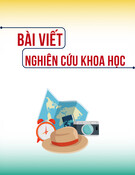
![Đề cương ôn tập Bản đồ du lịch [năm hiện tại]](https://cdn.tailieu.vn/images/document/thumbnail/2025/20250809/dlam2820@gmail.com/135x160/53061754884441.jpg)
